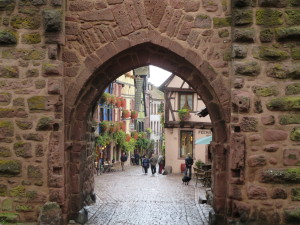This summer I’ll be spending several weeks helping to guide travelers through Europe’s best sights. A dream job to be sure, but the stakes are high; the task of introducing people to the richness of Europe can be a heavy burden. Being in charge of a group’s travel safety and general exposure to the rich cultural treasures of any place is a daunting responsibility.

I adore this French village in Alsace region.
Curating a group’s travel experience is not for the faint of heart. The question is always how best to introduce people to the buzzing urban intensity of Rome, the humid, decadent decay of Venice and the vertigo-inducing heights of the chilly Swiss Alps. One person’s death march through the hot, crowded streets of Florence is another’s carnival of once-in-a-lifetime Renaissance sights. On the other hand, consider that same tour member’s restless boredom in an ancient half-timbered German hamlet. It’s another’s perfect medieval village vacation under the shadow of a ruined castle looming in the hills above.
The main task of any good tour guide is, of course, to help people connect to the history, the people and the culture of the place they’ve come so far to see. And different people connect to the culture in different ways. Some come for the food, while others could care less about the cuisine scene. Some just want to take in the sights, while still others need every historical detail you can offer them. One tour member’s Michelangelo is another’s gelato; it’s not right or wrong. It’s just different, because people are different.

A good guide can gently expose a conservative American mom to the permissive hedonism of canal-laced Amsterdam, and inspire her to think about the Dutch culture’s success in keeping drug abuse and teen pregnancy to record lows compared to our nation’s sad stats. Or bring the history of an otherwise lifeless site to life through a well-rendered story detailing the intense human drama it witnessed. The same guide can introduce the tired, indifferent sightseer to the majesty of the Louvre and the Uffizi Gallery, and walk out with a convert to the flashy, fleshy vividness of Renaissance humanist art.
So the tour guide’s other main challenge, then, is to help one connect to the place in their own way, on their terms. In other words, help them find what they’re looking for—and sometimes what they didn’t know they were looking for. Some come for enlightenment and some come for a good time. There is no reason they can’t leave with both, their bag filled with insights and fun memories that will last a lifetime.
